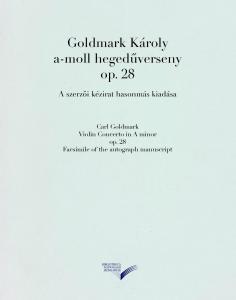
Carl Goldmark Violin Concerto in A minor op. 28
Carl Goldmark Violin Concerto in A minor op. 28
Facsimile edition of the autograph manuscript.
Introductory study written by Balázs Mikusi
Budapest, National Szécsényi Library, 2019., 168 pages
Language: Hungarian, English
ISMN 979-0-801675-23-1
Carl Goldmark was one of the most celebrated opera composers of his time. The Queen of Sheba was received with enthusiasm throughout Europe following the 1875 premiere in Vienna. But the ‘Goldmark cult’ of Vienna in the 1910s was not lasting, and the composer’s pieces disappeared from opera stages and concert shows a few decades later.
The Goldmark legacy, purchased by the Hungarian state in the late 1920s, arrived to its permanent keeper institution, to the National Széchényi Library in 1978, where the current head of the Music Collection, István Kecskeméti, catalogued the entire material with academic thoroughness. Our publication publishes one of the outstanding documents of this legacy, the autograph manuscript of Goldmark’s Violin Concerto in a facsimile edition of the same size. The date and place of finishing the 72-folio manuscript are indicated by the composer’s signature under the final measures of the score. In addition to the full autograph preserved in the Music Collection of the NSZL, the volume also includes the eight-page supplement that emerged from the author’s legacy later and now belongs to the collection of the Wienbibliothek im Rathaus in Vienna.
The premiere of the Violin Concerto was certainly held in Vienna on 10 November 1878, after the manuscript had been completed: the soloist Johann Christoph Lauterbach was accompanied by the orchestra of the Gesellschaft der Musikfreunde conducted by Eduard Kremser. Several contemporary critics reported about the play and performance, and the reception was not entirely commendable. But despite the far from unanimously positive opinion of his contemporaries, one hundred and forty years later it seems clear that one of Goldmark’s major works composed after the The Queen of Sheba is the Violin Concerto, which was played in concerts even around the middle of the 20th century, and can claim a virtually unbroken performance tradition. Moreover, in recent decades, it has been experiencing a distinct renaissance, enriching the romantic concerto repertoire of generations of young violinists.
The publication not only pays tribute to the now almost forgotten master, but also promises exciting discoveries for musicians and music researchers, with Balázs Mikusi’s introductory study providing guidance for these.
Shopping
Our publications are available in our bookshop, or can be ordered from the Publications Department of the NSZL using the contact details below: Főigazgatói Kabinet kiadványtára, Országos Széchényi Könyvtár, 1276 Budapest P.O. box 1205., phone: 06-1-23-23-506, e-mail: kiadvanytar@oszk.hu.




